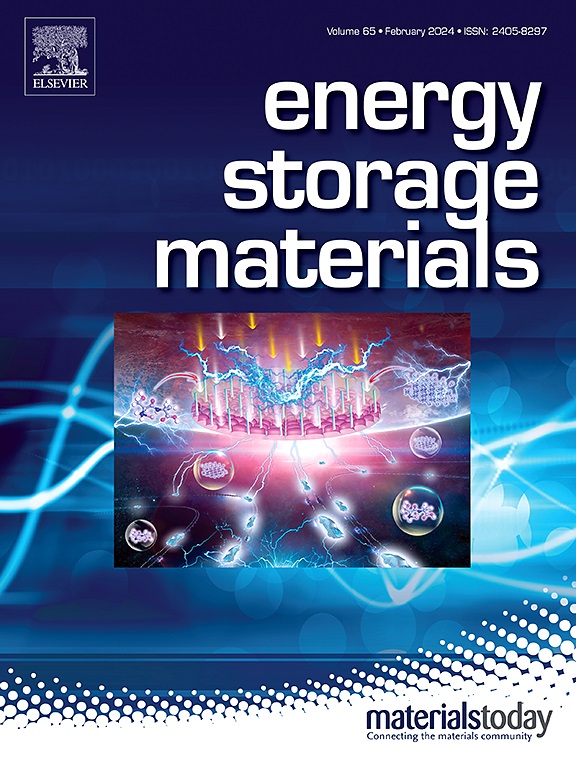Synchronized regulating Zn2+ depositing/stripping processes to achieve ultra-stable aqueous zinc metal batteries
IF 18.9
1区 材料科学
Q1 CHEMISTRY, PHYSICAL
引用次数: 0
Abstract
The dendrites and parasitic reactions of zinc anodes constitute the critical bottleneck limiting the stable cycling of aqueous zinc-ion batteries. Regulating the depositing process of zinc ions and regulating the stripping process of zinc ions are both important to circumvent these parasitic reactions and zinc dendrites. However, there is still a lack of simple strategies that can effectively regulate the deposition and stripping behaviors of zinc ions on two opposite electrodes simultaneously. To address this challenge, we engineer copper disodium ethylenediaminetetraacetate (EDTA-CuNa2) as a multifunctional electrolyte additive to efficiently and synchronously regulate both Zn2+ depositing and stripping processes. On the deposition side, Cu2+ maintains persistent exposure of zincophilic alloy sites, reducing the overpotential of zinc nucleation, while Na+ suppresses the growth of zinc dendrites via electrostatic shielding effects. On the stripping side, the interfacial molecular layer arranged by adsorbed EDTA4- ligands facilitates uniform zinc stripping and prevents the proximity of sulfate ions to the electrode, which evades the formation of electrode surface defects caused by disordered Zn2+ stripping as well as the generation and aggregation of alkali by-products, thus maintaining the flatness of the stripping surface. The synergistic effect of the two aforementioned functions results in excellent cycling stability: Zn||Zn symmetric batteries manifest the stable cycling over 2500 h at 30 mA cm-2/1 mAh cm-2, and Zn||Cu half-batteries maintain >3700 cycles at 1 mA cm-1/0.5 mAh cm-2. This research delivers an exemplification for electrolyte additive-enabled uniform zinc deposition and stripping, carving out a novel pathway for realizing highly stable zinc-metal batteries.
同步调节Zn2+沉积/剥离工艺实现超稳定水性锌金属电池
锌阳极的枝晶和寄生反应是制约水性锌离子电池稳定循环的关键瓶颈。调节锌离子的沉积过程和锌离子的剥离过程对克服这些寄生反应和锌枝晶具有重要意义。然而,目前还缺乏一种简单的策略,可以有效地调节锌离子同时在两个相对电极上的沉积和剥离行为。为了应对这一挑战,我们设计了乙二胺四乙酸铜二钠(EDTA-CuNa2)作为多功能电解质添加剂,以有效地同步调节Zn2+沉积和剥离过程。在沉积侧,Cu2+维持了亲锌合金位点的持续暴露,降低了锌成核的过电位,而Na+通过静电屏蔽作用抑制了锌枝晶的生长。在汽提侧,由吸附的EDTA4-配体排列的界面分子层有利于锌的均匀汽提,防止了硫酸盐离子靠近电极,避免了Zn2+汽提无序导致电极表面缺陷的形成以及碱副产物的生成和聚集,从而保持了汽提表面的平整度。上述两种功能的协同作用导致了优异的循环稳定性:Zn||Zn对称电池在30 mA cm-1/ 2 mAh cm-2下可稳定循环2500 h以上,Zn||Cu半电池在1 mA cm-1/0.5 mAh cm-2下可保持超过3700次循环。本研究为电解质添加剂的均匀锌沉积和剥离提供了一个范例,为实现高稳定的锌金属电池开辟了一条新的途径。
本文章由计算机程序翻译,如有差异,请以英文原文为准。
求助全文
约1分钟内获得全文
求助全文
来源期刊

Energy Storage Materials
Materials Science-General Materials Science
CiteScore
33.00
自引率
5.90%
发文量
652
审稿时长
27 days
期刊介绍:
Energy Storage Materials is a global interdisciplinary journal dedicated to sharing scientific and technological advancements in materials and devices for advanced energy storage and related energy conversion, such as in metal-O2 batteries. The journal features comprehensive research articles, including full papers and short communications, as well as authoritative feature articles and reviews by leading experts in the field.
Energy Storage Materials covers a wide range of topics, including the synthesis, fabrication, structure, properties, performance, and technological applications of energy storage materials. Additionally, the journal explores strategies, policies, and developments in the field of energy storage materials and devices for sustainable energy.
Published papers are selected based on their scientific and technological significance, their ability to provide valuable new knowledge, and their relevance to the international research community.
 求助内容:
求助内容: 应助结果提醒方式:
应助结果提醒方式:


